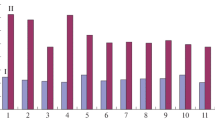Abstract
For the development of a perfusion culture producing recombinant human protein C, the effects of fetal calf serum and growth factors on cell growth and recombinant protein production were investigated. Although the growth of recombinant cells was stimulated by serum in a dose-dependent manner, a lower concentration of serum (2%) could support both synthesis and post-translational modification of protein C as efficiently as 10% serum. Among the growth factors tested, transferrin enhanced protein C production to the level comparable with 10% serum, while insulin was effective in maintaining cellular metabolism. Based on these results, a perfusion culture for a scale-up production of recombinant protein C was done using an Opticell culture system. A good productivity of the recombinant protein was obtained in low serum or serum-free medium for more than one month.
Similar content being viewed by others
References
Barnes D & Sato G (1980) Methods for growth of cultured cells in serum-free medium. Anal. Biochem. 102: 255–270.
Bebbington C & Henteschel C (1985) The expression of recombinant DNA products in mammalian cells. Trends in Biotechnol. 3: 314–317.
Esmon CT (1987) The regulation of natural anticoagulant pathways. Science 235: 1348–1352.
Goto M, Akai K, Murakami A, Hashimoto C, Tsuda E, Ueda M, Kawanishi G, Takahashi N, Ishimoto A, Chiba H & Sasaki R (1988) Production of recombinant human erythropoietin in mammalian cells: host-cell dependency of the biological activity of the cloned glycoprotein. Bio/Technology 6: 67–71.
Hakomori S (1970) Cell-dependent changes of glycolipid concentrations in fibroblasts, and loss of this response in virus-transformed cells. Proc. Natl. Acad. Sci. U.S.A. 67: 1741–1747.
Johnson G & Schwartz J (1976) Effects of sugars on the physiology of cultured fibroblasts. Exp. Cell Res. 97: 281–290.
Kaufman RJ, Wasley LC, Spilotes AJ, Gossels SD, Latt SA, Larsen GR & Kay RM (1985) Coamplification and coexpression of human tissue-type plasminogen activator and murine dihydrofolate reductase sequences in Chinese hamster ovary cells. Mol. Cell. Biol. 5: 1750–1759.
Kisiel W (1979) Human plasma protein C: isolation, characterization and mechanism of activation by α-thrombin. J. Clin. Invest. 64: 761–769.
Kurosawa-Ohsawa K, Kimura M, Kume-Iwaki A, Tanaka T & Tanaka S (1990) Anti-protein C monoclonal antibody induces thrombosis in mice. Blood 75: 2156–2163.
Lyderson BK, Pugh GG, Paris MS, Sharma BP & Noll LA (1985) Ceramic matrix for large scale animal cell culture. Bio/Technology 3: 63–67.
Mccormic F, Trahey M, Innis M, Dickman B & Ringold G (1984) Inducible expression of amplified human beta interferon gene in CHO cells. Mol. Cell. Biol. 4: 166–172.
Smiley A, Hu W-S & Wang DIC (1989) Production of human immune interferon by recombinant mammalian cells cultivated on microcarriers. Biotechnol. Bioeng. 33: 1182–1190.
Sugiura T, Kurosawa-Ohsawa K, Takahashi M & Maruyama HB (1990) Relationship between productivity and γ-carboxylation efficiency of recombinant protein C. Biotechnol. Lett. 12: 799–804.
Sugiura T & Maruyama HB (1991) Factors influencing expression and post-translational modification of recombinant protein C. J. Biotechnol. (in press).
Sugo T, Persson U & Stenflo J (1985) Protein C in bovine plasma after warfarin treatment. J. Biol. Chem. 260: 10453–10457.
Suttie JW (1985) Vitamin K-dependent carboxylase. Annu. Rev. Biochem. 54: 459–477.
Takeshita S, Tezuka K-I, Honkawa H, Matsuo A, Matsuishi T & Hashimoto-Gotoh T (1988) Tandem gene amplification in vitro for rapid and efficient expression in animal cells. Gene 71: 9–18.
Tsuboi A, Kurotsu T & Terasima T (1976) Changes in protein content per cell during growth of mouse L cells. Exp. Cell Res. 97: 257–261.
Urlaub G & Chasin L (1980) Isolation of Chinese hamster cell mutants deficient in dihydrofolate reductase activity. Proc. Natl. Acad. Sci. U.S.A. 77: 4216–4220.
Yamada K, Ikeda I, Sugahara T, Hashizume S, Shirahata S & Murakami H (1989) Stimulation of proliferation and immunoglobulin M production by lactoferrin in human-human and mouse-mouse hybridomas cultures in serum-free conditions. Cytotechnology 3: 123–131.
Author information
Authors and Affiliations
Additional information
Address for offprints: Laboratory for Molecular Biology, Pharma Research Laboratories, Hoechst Japan Ltd., 1-3-2, Minamidai, Kawagoe, Saitama 350, Japan
Rights and permissions
About this article
Cite this article
Sugiura, T., Maruyama, H.B. Production of recombinant protein C in serum-containing and serum-free perfusion culture. Cytotechnology 7, 159–164 (1991). https://doi.org/10.1007/BF00365926
Received:
Accepted:
Issue Date:
DOI: https://doi.org/10.1007/BF00365926




